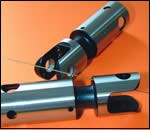EDM Drill Solves Oil Passage Problem
This manufacturer was having a problem machining a 0.025-inch diameter oil feed hole at an angle in a hardened steel component called the Bronson Roller. The 30-degree angle of entry and the hardened condition of the roller body made it a difficult task for conventional drilling. The part was one of a family of parts that vary in OD and oil hole angle of entry.
Royal Oak Industries produces engine blocks and fuel system components for the heavy truck, marine, agricultural, off-road heavy equipment and other industries. One of its parts-manufacturing divisions, Bronson Precision Products (Bronson, Michigan), was having a problem machining a 0.025-inch diameter oil feed hole at an angle in a hardened steel component called the Bronson Roller. The 30-degree angle of entry and the hardened condition of the roller body made it a difficult task for conventional drilling. The part was one of a family of parts that vary in OD and oil hole angle of entry.
The search for a better hole-drilling method led Bronson’s engineers to investigate the Astec high speed EDM drill manufactured by Belmont Equipment and Technologies, a division of Cleary Developments (Madison Heights, Michigan). Although EDM drills are widely used for production drilling of small-diameter holes in aerospace and land-based turbines, there was some concern that the process might be too slow to process the roller bodies in the volumes required. A demonstration at Belmont’s Madison Heights showroom convinced the Bronson engineers that EDM drilling of the oil passages provided an efficient solution to the problem, even with the large volumes being considered.
Belmont’s EDM drilling machines come in various models and configurations, and after several discussions between the engineers of both companies, it was decided that an Astec Model A34 CNC three-axis machine would meet Bronson’s requirements. The gantry-style machine offers X- and Y-axis travels of 12 inches and 16 inches respectively, and it features a 16- by 19-inch work area. It can produce holes in any conductive material, hardened or not, using inexpensive tubular brass electrodes with high-pressure water dielectric flush through the center. Because EDM is a non-contact process, the angle of entry of the electrode is not a problem. Where use of conventional drills would probably result in deflection, the EDM drilling process results in straight, burr-free holes. After studying the process and running tests on actual components, it was decided that the most effective way to process the parts was in batches of 60. The work area accommodates four fixtures, each holding 15 parts. All 60 parts are drilled by the machine operating in an unattended mode during a 45- to 60-minute interval, depending on the part. Four electrodes are consumed in the process, necessitating the machine’s automatic electrode changer feature.
Electrode wear as the machining progresses is detected by the machine’s Auto-Z feature, which is built into the control. This feature resets zero on the Z axis at the first spark, thus compensating for wear. The machine then drills to the programmed depth on each hole, ensuring consistency from hole to hole. The retract stroke and all other EDM machine settings are contained in the program.
The machine begins each hole with low electrode power (ensuring a clean entrance hole) that gradually increases to full power as the cut progresses. The small, controlled initial spark reduces burrs and work surface scars usually caused by molten splatter, thus maintaining surface integrity and eliminating need for post-processing, which are key factors for Bronson.
Read Next
Do You Have Single Points of Failure?
Plans need to be in place before a catastrophic event occurs.
Read MoreA Tooling Workshop Worth a Visit
Marubeni Citizen-Cincom’s tooling and accessory workshop offers a chance to learn more about ancillary devices that can boost machining efficiency and capability.
Read More5 Aspects of PMTS I Appreciate
The three-day edition of the 2025 Precision Machining Technology Show kicks off at the start of April. I’ll be there, and here are some reasons why.
Read More



















